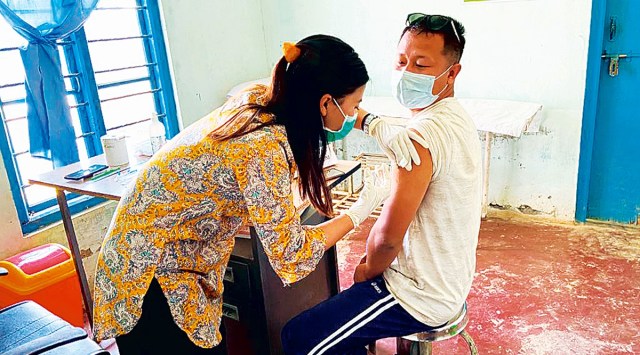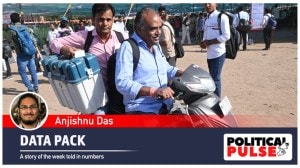- India
- International
A shot story: How a remote village near Myanmar border got to 95%
“I told them Covid is bad, vaccine is good. So you take the vaccine”
 ‘I told them Covid is bad, vaccine is good,’ says Hungyo Levis. (Express photo)
‘I told them Covid is bad, vaccine is good,’ says Hungyo Levis. (Express photo)Ever since she got vaccinated, Hungyo Levis has been an object of curiosity in Ningchou village in Manipur’s Kamjong district. “Are you sick? Are you okay? ” her neighbours asked her in March, after she got the first shot.
Sixty and diabetic, Levis — schooled by her social worker son — knew better. “I told them Covid is bad, vaccine is good. So you take the vaccine,” she says. Not many were convinced.
Of late, however, as cases have increased, Levis has turned into a role model of sorts. “Seeing that nothing happened to me, many came forward to take the vaccine,” she says.
Like Levis, a doctor in Imphal, an Army official in Assam, a government worker in Shillong — all of whom originally hail from Ningchou — have played a part in helping the village achieve almost 95% vaccination rate, a happy anomaly for a district with an otherwise poor coverage. As of June 10, Kamjong had administered only 7.1 doses per 100 people.
“The idea was to get educated people from Ningchou vaccinated,” said Worshang Hungyo, DC, Kamjong, who also hails from Ningchou. “This inspired others to so the same.”

Carved out of Ukhrul in 2016, Kamjong is one of Manipur’s remotest districts, bordering Myanmar. Primarily inhabited by the Tangkhul Naga tribe, and Kuki tribe in some pockets, the district, with a population about 55,000, has 140 villages, accessible only by rugged hilly roads.
“And sometimes, no roads, especially during the monsoon,” says Dr M C Mascot, a medical officer at Kamjong. And so, vaccinating its population has been an uphill task for the administration. “The vaccines come from the cold storage facility in Ukhrul. They are then taken to the four subdivisions in Kamjong,” said Dr Prakash, district immunisation officer. “To then get it to far-flung villages with terrible roads is even more difficult.” The farthest village lies at least 70 km away, and could take five-six hours to reach.
What makes it worse are the rumours that fuel vaccine hesitancy. “One day, a WhatsApp message said that the vaccine leads to impotency…,” says Dr Mascot. In the predominantly Christian villages, some also believe that the vaccine is associated with the number 666, which represents the devil in Christianity.
Dr Mascot added that the administration was putting up banners to counter misinformation, and taking help from the Tangkhul Medical Association and Church to motivate people.
In Ningchou, a number of young people were also roped in for the job, among them, 27-year-old Leishingam. “My friends and I went door to door to convince people. We told them that look, your PM, your CM all are taking vaccines, they are safe, you will be too.”
For the 60+ age group, the vaccinating team was sent to the village. For the younger lot, cars were sent so they could be brought to the local Community Health Centre (CHC) to get their shots. Since it is a newly established district, Kamjong’s health infrastructure — with two PHCs and one CHC — is still in its formative stages. Fortunately, there have been no serious cases or Covid deaths so far.
Says DC Worshong: “Our biggest learning from Ningchou was villagers will not come to you; you have to go to them.”
Apr 25: Latest News
- 01
- 02
- 03
- 04
- 05








































